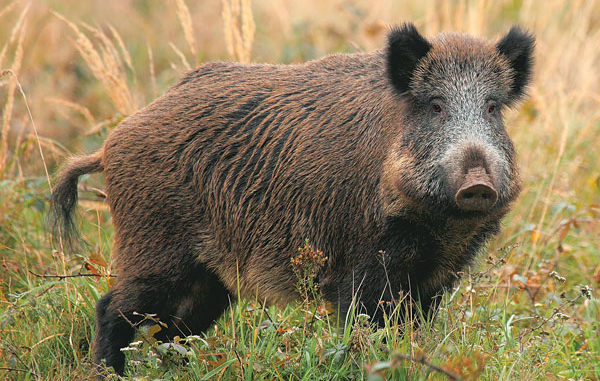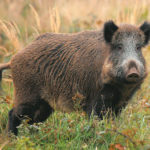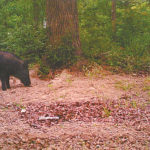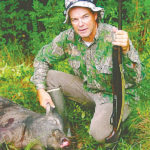
As I have mentioned before, it seems like there is an article about feral hogs in every hunting and wildlife magazine on the stands. Since the season is wide open on pigs, I have made an effort to hunt them hard this summer and reduce their numbers around Camp David.
While it would be nice to refer to it as an eradication program, the fact is eradicating feral hogs from the landscape is simply not going to happen unless the wildlife vets come up with a wonder drug that will target only hogs and not other creatures.
I had begun baiting at a site on the east property line with the idea that this would keep the hogs from coming into the forage plantings like they did last year. A good idea, but I discovered that it didn’t work; I found a major eat-out in my sorghum/soybean/jointvetch planting while applying some fertilizer in early July. The hogs had eaten their way into the plot, and there was a big circle of downed vegetation. I have seen them do this in corn and milo fields.
If the pigs stop coming to my other bait site this might be a good site to start baiting.
The hogs also got into my corn that I had planted with some green beans in a couple of small patches. I had made a small picking of the corn, and despite the lack of rain, was going to get maybe a dozen or more ears. However, the hogs literally targeted every corn stalk in these two patches and prevented us from enjoying some more summer corn.
When the turkey season ended in April, I started baiting for hogs, and it wasn’t long before the pigs were addicted to the rice bran and corn. Using a Bushnell Trophy Cam to monitor the site, I learned that several boars and a group of sows with piglets were coming to the bait.
I purchased a few solar lights from Lowe’s and set them up to illuminate the site for some night hunting. A person can shoot pigs at night with buckshot without the need of a permit from LDWF.
I set up a ladder stand near the site, making sure the distance was adequate for a round of buckshot. I made a few preliminary hunts to see how the gear worked, and discovered I needed to get more sun on the solar panels to keep my lights on during most of the night. The area is somewhat shady and the lights need good sun to stay charged.
I found that the set of three solar lights with a larger sun panel works better than the two individual lights that have a small panel that I initially set up. I keep the bait at two spots near one another so that if a group of hogs shows up, they hopefully will separate and give targets for multiple shots.
In early May, the pigs were tearing up the bait; I went up for a late hunt Sunday evening, and discovered the sow and piglets had been at the bait at 3 p.m. Just before dark, I heard the cracking of tusks, and a big boar made an appearance in the woods but did not come to the bait. If I had my rifle instead of the shotgun, it would have been an easy shot.
I hunted a little while into the night, went to bed and got up early the next morning, but the hogs were obviously doing something else. I was back in the stand early the next afternoon, but the pigs didn’t show up until 7 p.m..
I was, however, back in Baton Rouge with the first hog in the cooler earlier than expected.
Death in the pine straw
After a few days, the pigs were back on the bait, and it was time to do some more hunting. With the camera doing the scouting, it is fairly easy to determine the hunt time.
My buddy Mark McElroy came up with a friend on the night of May 18, and we sat at the bait site for an hour. According to the camera, the pigs had been on the bait prior to us showing up, so we may have spooked them.
I set the alarm for 5 a.m., and when I heard the promo music for the WJ Show, I hurried out to the site. Photos were taken of the hogs at 4:48 and 5:16 a.m., and I fired three shots at them at 5:30 a.m. I heard an animal running through the strip of woods to my left, and then it was all quiet. I looked briefly for blood and finding none decided I better get more ammo in case one was wounded, so I went back to the camp for the pistol and took time to call my friend Ken Mason, who was getting ready to go teach at a school in Benton. Ken had been calling to check on us regarding the flooding, and I had not been able to call him back. I informed him I might have a pig on the ground, and he laughed. Their 10,000-acre club in Bossier Parish is infested with them.
I went back to the scene and started looking. I went about 30 yards in the direction I had heard the running, looked up and saw something black behind a big pine tree. I eased up, and sure enough Hog No. 2 was dead in the pine straw.
Rhino Boar goes down
A few days later, the hogs were back on the bait again. The Bible says a dog returns to its vomit, so I guess one can say that a pig returns to its grub. Usually, once the pigs have received free lead they are reluctant to return, but these pigs must be addicted to the powder. Once again the photos were showing hogs on the bait in the early morning hours, so I told Mac to meet me at Camp David for 4 a.m. on May 28.
At 4:30, we were easing out to the bait site, and as we got closer, we heard the sounds of several hogs grunting and carrying on. I could see the big Rhino Boar on one pile of bait and some black pigs at another.
We fired two shots with the aid of the solar lights, and heard pigs running in all directions. There was blood at the bait site, so we decided to go back to Camp David and wait for light. We listened to Don Dubuc to pass the time; we thought about calling and talking hog hunting with him, but didn’t want to interrupt the fishing talk.
We picked up the blood trail, and in short order found the big boar dead in the grass. We searched the area for more pork, but finding none, I got the John Deere and we prepared Hog No. 3 for the trip to the butcher shop. This boar had broken tusks, weighed around 200 pounds and was caked with rice bran.
The last boar of the summer
Over a week went by without any hog visits, but on June 10 another boar was starting to show up. I made a hunt the night of June 12 without any luck; I did see a world-record raccoon that must have weighed 50 pounds. But thanks to modern technology, his days would be numbered.
Work kept me from hunting the bait site like it should be done, and the rest of June was pretty much a bust.
July started out slowly also, but by the 14th of the month, the hogs were becoming regular visitors; so on the night of the 19th I got in the stand around 7 p.m., determined to wait them out.
The regular visitors to the bait, coons and possums, were out at 8:30, and there was lots of moving around as they competed for the best feeding spot. Right before 10 p.m., these critters scattered in all directions, which somewhat perked me up. These varmints have done this before without any hog walking in, but this time a big black head appeared from the darkness into the light. It was a little eerie watching a 200-pound animal standing half in and half out of the light.
The boar was a little nervous, perhaps wary of the new pile of rice bran, and turned and eased back into the darkness. A few minutes later, it appeared from the brush, and started eating corn. Two shots of my new Mossberg 930 put it down on the ground and into the cooler.
I decided to stop the hog hunting for the month of August — too much going on — but will resume in September. While hog eradication may not happen, hog hunting definitely adds some extra days to the hunting season, thanks to solar power.





